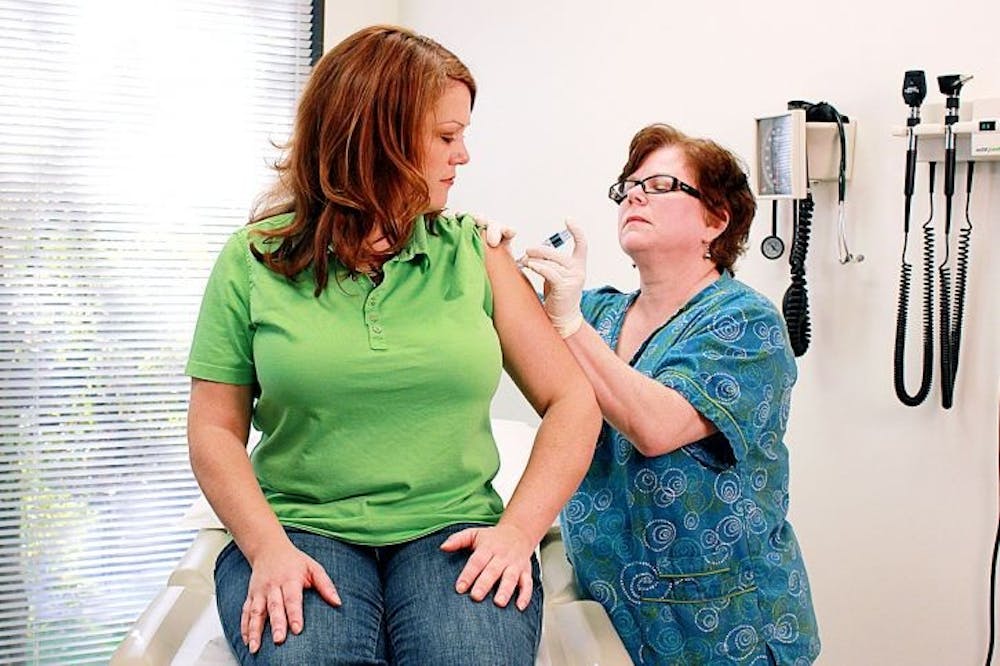When temperatures begin to drop and leaves change from their summer green to shades of orange, red and yellow, it is not only a sign that fall has arrived, but also a sign of another season as well — flu shot season.
Clinics nationwide offer flu shots during the fall months for individuals looking to get vaccinated against the predicted most common or dangerous strands of the year.
The hope is always that the flu shot will provide optimal protection against the disease; however, its effectiveness is limited to the strains of flu from which it was made. This means that the effectiveness and success of the flu shot can vary on a year-to-year basis.
New research from the University of Nebraska Center for Virology offers a solution to this problem. Researchers there have concocted a vaccine they hope may one day replace all flu vaccines as a universal vaccine.
The vaccine was created using ancestral genes from four major influenza strains. The goal is not only for it to alleviate the need to select which strands to protect against each year, but also to remove the need for an annual flu shot all together.
Ideally the vaccine would provide lifelong protection against influenza.
The vaccine was developed on mice and has yet to be tested on humans. During the experiment, mice were given traditional influenza vaccines as well as the new vaccine. All of the mice were then exposed to lethal doses of nine varying flu viruses.
The results were that those who had received the traditional vaccine got sick and died. Those who received the new vaccine, however, survived. A further indicator of the new vaccine’s success was that mice who had received particularly high dosages of the vaccine experienced no symptoms at all.
The research was led by Eric Weaver, an assistant professor in the School of Biological Sciences at the University of Nebraska-Lincoln. In his study, Weaver used a technique involving multiple centralized hemagglutinin genes.
Hemagglutinin is a spike-shaped protein that exists on the edges of influenza viruses and aids in attacking human cells.
While Weaver has not been the first to attempt to create a universal vaccine, he is the first to use this strategy in particular. The specific hemagglutinin genes were identified using protein sequence analysis programs to select genes that would provide optimal protection.
Traditional influenza vaccines rely on weakened or dead influenza viruses. This virus is injected into the human body to encourage human immune cells to build up the necessary protection against the particular virus.
Rather than utilizing weakened or dead influenza virus, Weaver and his team focus on synthesizing genes common to all influenza strains or genes that can be traced back to the origins of the disease.
“Our idea is that these centralized antigens can set up a foundation of immunity against influenza. Because they are centralized and represent all the strains equally, they could provide a basis for immunity against all evolved strains,” Weaver said, according to ScienceDaily.
Moving forward, Weaver hopes to continue to explore the possibilities of using ancestral influenza genes to create a viable vaccine for humans.
While the vaccine is still far from ready for human use, it has the potential to have a significant impact.
The Centers for Disease Control and Prevention (CDC) reported that forty million Americans contracted the flu during the 2015-2016 flu season. Of those people, 970,000 were hospitalized.
The CDC also estimated that influenza vaccines prevented 1.9 million illnesses and 67,000 hospitalizations.
This data illustrates the influenza vaccine’s potential for improvement.
“To put this in other terms, our current influenza vaccine programs and technologies reduce influenza infections and hospitalizations by 4.75 percent and 6.9 percent, respectively. There is no doubt that there is a need for more effective vaccine technologies,” Weaver said.
While Weaver and his team are not the first to explore the possibility of a universal vaccine (other ideas have included attacking proteins common to all flu strains, attacking the protein coat that protects the viral flu strain or even attacking a specific portion of the hemagglutinin protein), their success with mice indicates a potential for a universal flu vaccine.
Such a “universal” vaccine will not be ready anytime soon. The projected release date for such a vaccine by various experts in the field isn’t until 2020 or 2025, and that is assuming the technique can be proven effective when used on humans.





